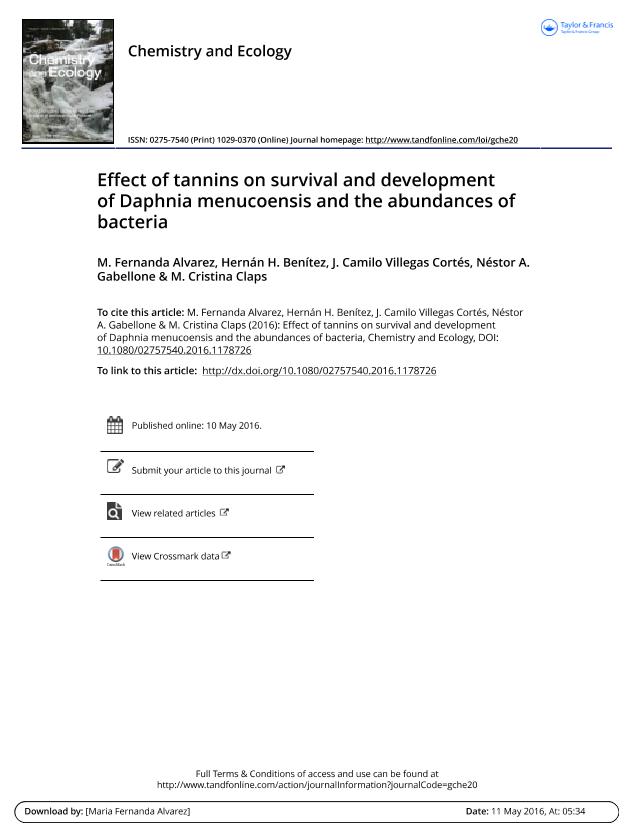Mostrar el registro sencillo del ítem
dc.contributor.author
Alvarez, María Fernanda

dc.contributor.author
Benitez, Hernan Hugo

dc.contributor.author
Villegas Cortés, J. Camilo
dc.contributor.author
Gabellone, Nestor Adrian

dc.contributor.author
Claps, Maria Cristina

dc.date.available
2017-09-04T18:17:04Z
dc.date.issued
2016-05-10
dc.identifier.citation
Alvarez, María Fernanda; Benitez, Hernan Hugo; Villegas Cortés, J. Camilo; Gabellone, Nestor Adrian; Claps, Maria Cristina; Effect of tannins on survival and development of Daphnia menucoensis and the abundances of bacteria; Taylor & Francis Ltd; Chemistry and Ecology; 32; 8; 10-5-2016; 742-755
dc.identifier.issn
0275-7540
dc.identifier.uri
http://hdl.handle.net/11336/23560
dc.description.abstract
Polyphenols – products of organic-matter decomposition entering water bodies from autochthonous and especially allochthonous sources – affect primary producers, bacterioplankton, and zooplankton to consequently modify food webs. Cladocerans are widely used in research experiments because they constitute the most frequent prey of high-trophic-level organisms in the majority of lakes, and certain species symbolise the ecologic prototype of the generalist filter feeder. In our study area’s shallow lakes, cladocerans, though generally of low abundance, do attain significantly high biomasses. We accordingly evaluated the mortality of the cladoceran Daphnia menucoensis Paggi, 1996 exposed to different tannin concentrations along with the bacterial abundance. In two experiments D. menucoensis females exposed to high tannin concentrations reproduced inefficiently, exhibited high mortality, and manifested altered behaviour, such as reduced reflexes and diminished mobility. Though tannins apparently affected algal abundances, the cladoceran herbivory strongly reduced those numbers. Positive effects on bacteria, however, were not recorded. High-allochthonous-organic-matter-containing water bodies support trophic webs because bacterioplankton provide an alternative energetic base for the zooplankton, as possibly occurs in shallow lakes of the Salado-River basin, characterised by cyclic hydrologic periods alternating between draught and flooding and intensive land use. In conclusion, tannins diminish D. menucoensis’s survival, locomotion, and the capacity to respond to stimuli.
dc.format
application/pdf
dc.language.iso
eng
dc.publisher
Taylor & Francis Ltd

dc.rights
info:eu-repo/semantics/openAccess
dc.rights.uri
https://creativecommons.org/licenses/by-nc-sa/2.5/ar/
dc.subject
Tannins
dc.subject
Zooplankton
dc.subject
Daphnia Menucoensis
dc.subject
Bacterioplankton
dc.subject.classification
Bioquímica y Biología Molecular

dc.subject.classification
Ciencias Biológicas

dc.subject.classification
CIENCIAS NATURALES Y EXACTAS

dc.title
Effect of tannins on survival and development of Daphnia menucoensis and the abundances of bacteria
dc.type
info:eu-repo/semantics/article
dc.type
info:ar-repo/semantics/artículo
dc.type
info:eu-repo/semantics/publishedVersion
dc.date.updated
2017-08-15T14:28:45Z
dc.journal.volume
32
dc.journal.number
8
dc.journal.pagination
742-755
dc.journal.pais
Reino Unido

dc.journal.ciudad
Londres
dc.description.fil
Fil: Alvarez, María Fernanda. Consejo Nacional de Investigaciones Científicas y Técnicas. Centro Científico Tecnológico Conicet - La Plata. Instituto de Limnología "Dr. Raúl A. Ringuelet". Universidad Nacional de La Plata. Facultad de Ciencias Naturales y Museo. Instituto de Limnología; Argentina
dc.description.fil
Fil: Benitez, Hernan Hugo. Consejo Nacional de Investigaciones Científicas y Técnicas. Centro Científico Tecnológico Conicet - La Plata. Instituto de Limnología "Dr. Raúl A. Ringuelet". Universidad Nacional de La Plata. Facultad de Ciencias Naturales y Museo. Instituto de Limnología; Argentina
dc.description.fil
Fil: Villegas Cortés, J. Camilo. Universidad del Cauca-Colciencias; Colombia
dc.description.fil
Fil: Gabellone, Nestor Adrian. Consejo Nacional de Investigaciones Científicas y Técnicas. Centro Científico Tecnológico Conicet - La Plata. Instituto de Limnología "Dr. Raúl A. Ringuelet". Universidad Nacional de La Plata. Facultad de Ciencias Naturales y Museo. Instituto de Limnología; Argentina
dc.description.fil
Fil: Claps, Maria Cristina. Consejo Nacional de Investigaciones Científicas y Técnicas. Centro Científico Tecnológico Conicet - La Plata. Instituto de Limnología "Dr. Raúl A. Ringuelet". Universidad Nacional de La Plata. Facultad de Ciencias Naturales y Museo. Instituto de Limnología; Argentina
dc.journal.title
Chemistry and Ecology

dc.relation.alternativeid
info:eu-repo/semantics/altIdentifier/url/http://www.tandfonline.com/doi/full/10.1080/02757540.2016.1178726
dc.relation.alternativeid
info:eu-repo/semantics/altIdentifier/doi/http://dx.doi.org/10.1080/02757540.2016.1178726
Archivos asociados
